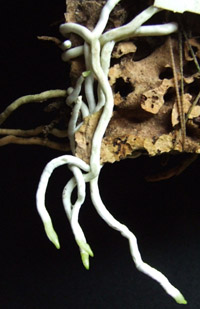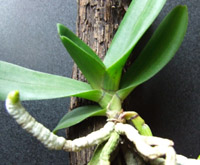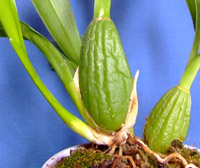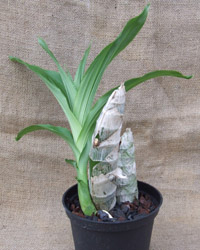As already mentioned, most orchids belong to the epiphytic, tree-dwelling species, whose roots cling to the bark of trees and, in symbiosis with special fungi, absorb nutrients from the air humidity and plant residues falling on the tree. (So they don’t parasitize the tree, as many believe.) Ensuring aeration of roots is therefore vital for plants, with the exception of a few soil-dwelling species (Ludisia, Ophrys, Cypripedium). The roots of epiphytic species often contain the green color of the leaves, chlorophyll, and some species do not develop leaves at all, in addition to flowering, all physiological functions are performed by the roots (Chiloschista, Polyrrhiza, Microcoelia). The young end of the roots absorbs water and minerals, and a dead tissue (dry white or silvery in color) filled with air around the older parts is used for water storage.

According to the type of growth, orchids can be divided into two groups. Monopodial-type plants grow from an active apical bud in only one direction, their leaves are in two rows facing each other, the flower stalk is brought from the side buds (genus Vanda, genus Phalaenopsis).

From sympathetic plants (creeping) rhizomes develop new lateral shoots each year, on which nutrient-storing pseudobulbs (i.e., dormant tubers) and leaves are formed. Depending on the species, the flower stem may develop from special buds (Lycaste) on the shoot apex (Cattleya), on the side of the shoot or on the leaf axils (Oncidium) and at the base of the stem, depending on the species.

The leaves can have very different structures depending on the living conditions. Thin, soft-leafed orchids live in damp and shady places, and a drop in humidity or total sunlight can cause them to perish. Species facing temporary drought and strong sunshine, on the other hand, develop succulent, vigorous foliage that serves as a storehouse of water and nutrients.
Perhaps surprising, but orchids have also evolved evergreen and deciduous species. In the case of evergreen plants, the leaves remain in the bulb for a few years, then after their fall, the bulb serves as a nutrient store for a long time, eventually dying. In the case of deciduous orchids, the leaves fall off annually, and new leaves appear only in the newly developing pseudobulba (some Dendrobium, Catasetum).

Knowing the above, we can now superficially form an idea of the needs of the plant in front of us, although of course there are many transitions.